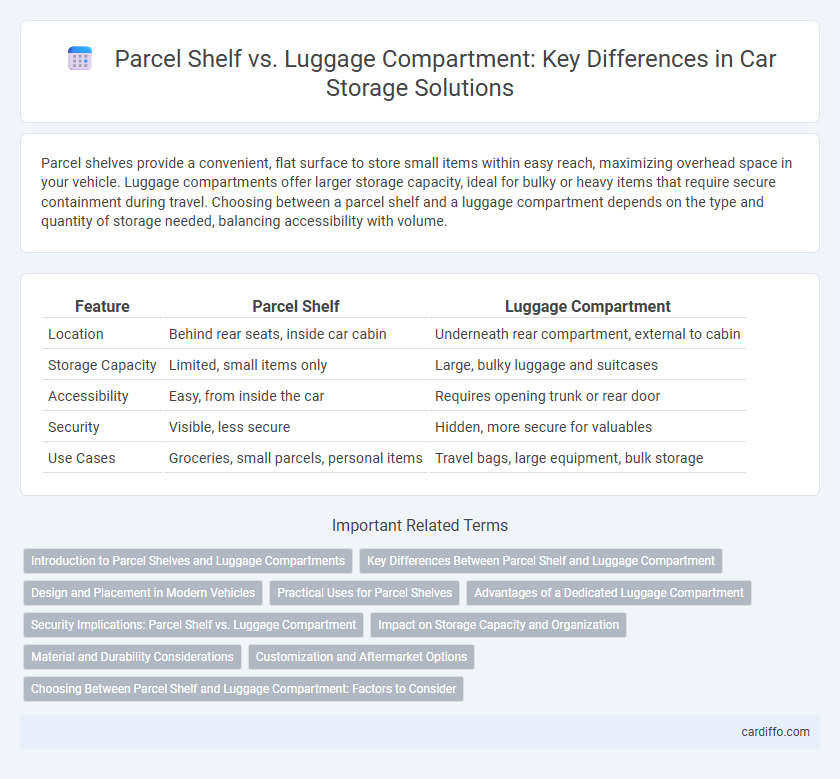Parcel shelves provide a convenient, flat surface to store small items within easy reach, maximizing overhead space in your vehicle. Luggage compartments offer larger storage capacity, ideal for bulky or heavy items that require secure containment during travel. Choosing between a parcel shelf and a luggage compartment depends on the type and quantity of storage needed, balancing accessibility with volume.
Table of Comparison
| Feature | Parcel Shelf | Luggage Compartment |
|---|---|---|
| Location | Behind rear seats, inside car cabin | Underneath rear compartment, external to cabin |
| Storage Capacity | Limited, small items only | Large, bulky luggage and suitcases |
| Accessibility | Easy, from inside the car | Requires opening trunk or rear door |
| Security | Visible, less secure | Hidden, more secure for valuables |
| Use Cases | Groceries, small parcels, personal items | Travel bags, large equipment, bulk storage |
Introduction to Parcel Shelves and Luggage Compartments
Parcel shelves provide convenient, easily accessible storage space typically located behind the rear seats, ideal for small items and everyday essentials. Luggage compartments are designed as larger, enclosed areas, usually found at the rear or under the floor, offering secure storage for bulky or heavy items during travel. Both storage solutions enhance vehicle organization but serve distinct purposes based on size, accessibility, and security needs.
Key Differences Between Parcel Shelf and Luggage Compartment
The parcel shelf is a flat, removable surface located behind the rear seats designed for light storage and to conceal belongings from view. The luggage compartment, also known as the trunk, offers a larger, enclosed space specifically built to hold heavier and bulkier items securely during transit. Unlike the parcel shelf, the luggage compartment typically provides more protection from weather elements and reduces noise from stored items.
Design and Placement in Modern Vehicles
Parcel shelves in modern vehicles are typically designed as flat, removable panels positioned directly behind the rear seats, offering quick access and a secure platform for lightweight items, which enhances cabin aesthetics and visibility. Luggage compartments, often located below or behind the parcel shelf, are engineered with deeper storage capacity, reinforced structures, and protective linings to accommodate heavier and bulkier luggage while maximizing underfloor space. The strategic placement and design of both storage solutions prioritize efficient space utilization, ease of access, and vehicle safety without compromising passenger comfort or cargo security.
Practical Uses for Parcel Shelves
Parcel shelves offer quick and easily accessible storage for small items like groceries, bags, or electronics, making them ideal for short trips or daily commutes. Unlike luggage compartments, parcel shelves provide overhead visibility and prevent items from rolling around, ensuring better organization within reach of the driver and passengers. These shelves enhance vehicle practicality by maximizing space without compromising passenger legroom or trunk capacity.
Advantages of a Dedicated Luggage Compartment
A dedicated luggage compartment offers enhanced storage capacity specifically designed for larger suitcases, allowing better organization and maximizing available space. This compartment reduces clutter in the passenger area and improves safety by securely containing heavy or bulky items during transit. It also helps maintain the vehicle's interior cleanliness and provides easier access to luggage without interfering with passenger comfort.
Security Implications: Parcel Shelf vs. Luggage Compartment
The parcel shelf offers limited security as items remain visible and more vulnerable to theft, whereas the luggage compartment provides concealed storage, significantly reducing the risk of unauthorized access. Electronic locking mechanisms in modern luggage compartments further enhance protection, making it the safer option for valuable belongings. Choosing the luggage compartment ensures better safeguarding against potential break-ins and theft compared to the exposed parcel shelf.
Impact on Storage Capacity and Organization
Parcel shelves offer quick-access storage for small items, enhancing cabin organization without reducing overall luggage space. Luggage compartments provide secure, larger storage areas that maximize capacity for bulky belongings but limit immediate accessibility. Choosing between the two depends on balancing the need for readily available items against maximizing total storage volume.
Material and Durability Considerations
Parcel shelves are typically made from lightweight materials like molded plastic or thin plywood, prioritizing easy removal and installation but often sacrificing long-term durability. Luggage compartments are constructed with robust materials such as reinforced steel frames or heavy-duty composites, designed to withstand heavy loads and resist wear from frequent use. Material choices significantly impact durability, with luggage compartments offering superior strength and resilience compared to the more fragile parcel shelves.
Customization and Aftermarket Options
Parcel shelves offer limited customization options with few aftermarket products available, primarily designed to conceal belongings and maintain vehicle aesthetics. Luggage compartments provide extensive customization possibilities, including modular inserts, cargo nets, and specialized organizers that enhance storage capacity and accessibility. Aftermarket solutions for luggage compartments often include customizable dividers, protective liners, and expandable storage systems catering to diverse user needs.
Choosing Between Parcel Shelf and Luggage Compartment: Factors to Consider
Choosing between a parcel shelf and a luggage compartment depends on factors such as storage capacity, security, and accessibility. Parcel shelves offer easy access for small items but provide limited protection and space, while luggage compartments accommodate larger, heavier bags with more security but less convenience for quick retrieval. Vehicle type, travel purpose, and the nature of stored items are critical considerations for optimizing storage solutions.
Parcel Shelf vs Luggage Compartment Infographic

 cardiffo.com
cardiffo.com